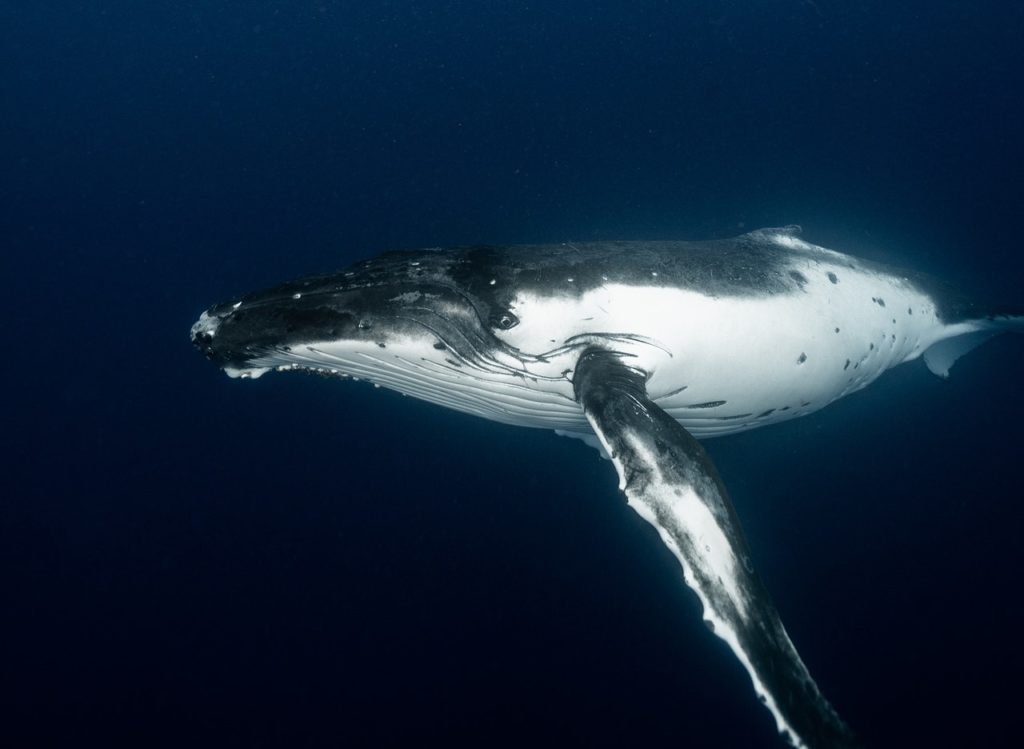
I learned this today. Whales make use of sound in the water because they cannot use their other senses.
It is not possible to use light to see underwater because the water scatters it too much. Plus, some whales dive over 2,000m and light doesn’t really penetrate much farther than 1,000m. They also cannot rely on a sense of smell because molecules diffuse more slowly in water than they do in air. This means they have to use sound to navigate and to communicate.
There are two major groups of cetaceans, and they produce sound in different ways. They are divided into toothed whales (odontoceti) and baleen whales (mysticeti).
Toothed whales include dolphins, porpoises, and sperm whales. They all have teeth, hence the name. (This is something else I learned today – dolphins are actually whales, and the killer whale is the largest dolphin!) Baleen whales have a plate of keratinaceous baleen in their mouth which they use to sieve plankton out of the water. The blue whale is a baleen whale.
Toothed whales produce sound in two different ways. They can make whistling sounds using their larynx, in the same way that we do. They can also produce high frequency sounds using the air sacs near their blowhole. They channel this sound through a large lump of fat at the front of their heads. This is called the melon. By changing the shape of this melon, they can change the frequency of the sound.
Baleen whales produce sound using a larynx. They have a thick ridge of tissue in their larynx next to an inflatable sac. By using their chest and throat muscles, they can inflate their lungs and this sac to cause different amounts of air to flow across the thick ridge making it vibrate at different frequencies. They can change the amplitude and frequency of the sound waves.
Both types of whales can also make sound by slapping their tail or other body parts on the surface of the water. Toothed whales clack their jaws together to make sound, usually when about to fight.
Whales use sound for different purposes. They use it for echolocation, communication, and sexual selection.
They use echolocation to “see” their way through the sea where light doesn’t reach. Toothed whales produce sound from the sac by their blowhole and change the frequency with their melon. This sound travels through the sea at 1,480 m/s because the speed of sound is faster in water. The sound wave hits an object and bounces back to the whale. The sound wave is picked up by an oil filled channel in the lower jaw and transmitted to the middle ear. The whale can use this to build a 3D picture of its surroundings. Usually, they use low frequency sounds for this. High frequency sounds can be used to stun prey.
Whales use low pitched sounds to communicate. These sounds travel a long way, and they can be used to keep track of pod members and keep track of the location of other whales during migration trips. They may be communicating other things that we don’t understand. Whales are very social beings and communication is very important for them.
They also use sound for sexual selection. Male humpback whales, for example, produce a lot of sound during the mating season. These songs tend to be similar through a season, but they are slightly different to the season before.
Whales from different pods, and even individual whales, have slightly different “accents”, presumably so they can tell each other apart and know members of their own pod.
Recently, noise pollution in the sea is increasing. Ship engines and propellers, submarines, oil drills, and other machines have been increasing and the amount of background noise is increasing. Whales are finding it harder to communicate and use their echolocation. The noise pollution has been blamed for the increasing number of whales that are beaching. It must be like trying to see while staring into a really bright light. Ambient ocean noise has increased by 12 decibels since the middle of the 20th century.
So, there are two types of whales, and they produce sound in different ways. Both types of whales use their sound for echolocation, communication, and sexual signaling. And this is what I learned today.
Photo by Elianne Dipp from Pexels
Sources
https://www.ifaw.org/journal/are-dolphins-whales
https://oceanservice.noaa.gov/facts/light_travel.html
https://en.wikipedia.org/wiki/Dolphin
https://en.wikipedia.org/wiki/Toothed_whale
https://en.wikipedia.org/wiki/Baleen_whale
https://en.wikipedia.org/wiki/Whale_vocalization
https://www.whalefacts.org/how-do-whales-communicate
https://www.jervisbaywild.com.au/blog/whales-dolphins-communicate/
https://oceanservice.noaa.gov/facts/whalesounds.html
https://www.awe.gov.au/environment/marine/marine-species/cetaceans/whale-dolphins-sound
